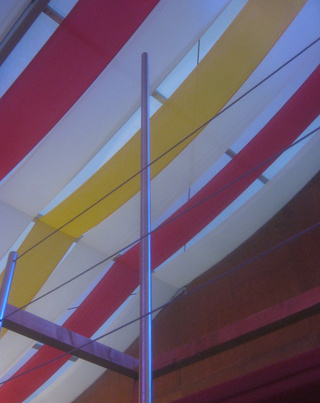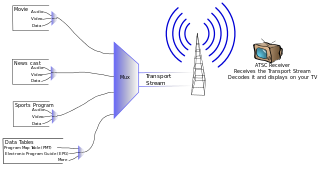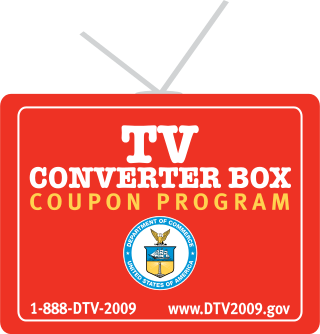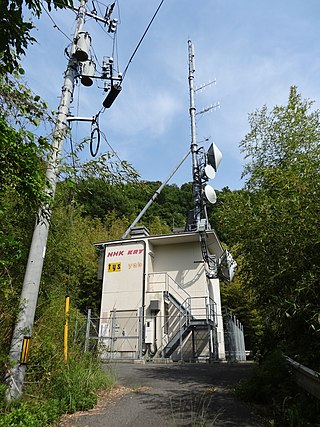Related Research Articles

Digital television (DTV) is the transmission of television signals using digital encoding, in contrast to the earlier analog television technology which used analog signals. At the time of its development it was considered an innovative advancement and represented the first significant evolution in television technology since color television in the 1950s. Modern digital television is transmitted in high-definition television (HDTV) with greater resolution than analog TV. It typically uses a widescreen aspect ratio in contrast to the narrower format (4:3) of analog TV. It makes more economical use of scarce radio spectrum space; it can transmit up to seven channels in the same bandwidth as a single analog channel, and provides many new features that analog television cannot. A transition from analog to digital broadcasting began around 2000. Different digital television broadcasting standards have been adopted in different parts of the world; below are the more widely used standards:

Low-power broadcasting is broadcasting by a broadcast station at a low transmitter power output to a smaller service area than "full power" stations within the same region. It is often distinguished from "micropower broadcasting" and broadcast translators. LPAM, LPFM and LPTV are in various levels of use across the world, varying widely based on the laws and their enforcement.

The All-Channel Receiver Act of 1962 (ACRA), commonly known as the All-Channels Act, was passed by the United States Congress in 1961, to allow the Federal Communications Commission to require that all television set manufacturers must include UHF tuners, so that new UHF-band TV stations could be received by the public. This was a problem at the time since most affiliated stations of the Big Three television networks were well-established on VHF, while many local-only stations on UHF were struggling for survival.
The class A television service is a system for regulating some low-power television (LPTV) stations in the United States. Class A stations are denoted by the broadcast callsign suffix "-CA" (analog) or "-CD" (digital), although very many analog -CA stations have a digital companion channel that was assigned the -LD suffix used by regular (non-class-A) digital LPTV stations.

An ATSCtuner, often called an ATSC receiver or HDTV tuner, is a type of television tuner that allows reception of digital television (DTV) television channels that use ATSC standards, as transmitted by television stations in North America, parts of Central America, and South Korea. Such tuners are usually integrated into a television set, VCR, digital video recorder (DVR), or set-top box which provides audio/video output connectors of various types.
KEGS was an independent television station in Goldfield, Nevada, United States. It served both the Reno and Las Vegas markets by way of translators KRRI-LP in Reno and KEGS-LP in Las Vegas. Like many stations that were owned by Equity Broadcasting, the stations were operated remotely by satellite; their programming could be seen free-to-air on Galaxy 18.
WNYI is a religious television station licensed to Ithaca, New York, United States, serving the Elmira, Binghamton and Syracuse television markets as an owned-and-operated station of the Daystar Television Network. The station's transmitter is located on Quarry Road in Moravia, New York. It shares its channel and tower with co-owned WDSS-LD, a low-power translator station that previously broadcast on UHF channel 38 from a transmitter in Onondaga.
KBGH, UHF analog channel 19, was an independent non-commercial educational television station serving Twin Falls, Idaho, United States that was licensed to Filer. The station's transmitter was located on Flat Top Butte near Jerome. Owned by the Twin Falls-based College of Southern Idaho (CSI), KBGH existed strictly as a means of providing telecourses and distance learning.

A digital television adapter (DTA), commonly known as a converter box or decoder box, is a television tuner that receives a digital television (DTV) transmission, and converts the digital signal into an analog signal that can be received and displayed on an analog television set. Some also have an HDMI output since some TVs with HDMI do not have a digital tuner. The input digital signal may be over-the-air terrestrial television signals received by a television antenna, or signals from a digital cable system. It normally does not refer to satellite TV, which has always required a set-top box either to operate the big satellite dish, or to be the integrated receiver/decoder (IRD) in the case of direct-broadcast satellites (DBS).

A coupon-eligible converter box (CECB) was a digital television adapter that met eligibility specifications for subsidy "coupons" from the United States government. The subsidy program was enacted to provide terrestrial television viewers with an affordable way to continue receiving free digital terrestrial television services after the nation's television service transitioned to digital transmission and analog transmissions ceased. The specification was developed by the National Telecommunications and Information Administration (NTIA), with input from the broadcast and consumer electronics industries as well as public interest groups.

A broadcast relay station, also known as a satellite station, relay transmitter, broadcast translator (U.S.), re-broadcaster (Canada), repeater or complementary station (Mexico), is a broadcast transmitter which repeats the signal of a radio or television station to an area not covered by the originating station.
KZNO-LD is a low-power television station in Los Angeles, California, United States. Owned by the Venture Technologies Group, it transmits from Mount Harvard, a peak adjacent to Mount Wilson in Los Angeles County, as a Spanish-language religious radio station that can be received at 87.7 FM. Its ATSC 3.0 video feed broadcasts Jewelry Television on digital channel 6.1.
Digital television in the United States is available via digital terrestrial television (DTT), digital cable, satellite television, and IPTV providers.
Analog passthrough is a feature found on some digital-to-analog television converter boxes. Boxes without the analog passthrough feature only allow older, analog-only TVs to view digital TV. Those with analog passthrough allow both digital and analog television to be viewed on older TVs.
The digital transition in the United States was the switchover from analog to exclusively digital broadcasting of terrestrial television programming. According to David Rehr, then president and CEO of the National Association of Broadcasters, this transition represented "the most significant advancement of television technology since color TV was introduced." For full-power TV stations, the transition went into effect on June 12, 2009, with stations ending regular programming on their analog signals no later than 11:59 p.m. local time that day.
In North American digital terrestrial television broadcasting, a distributed transmission system is a form of single-frequency network in which a single broadcast signal is fed via microwave, landline, or communications satellite to multiple synchronised terrestrial radio transmitter sites. The signal is then simultaneously broadcast on the same frequency in different overlapping portions of the same coverage area, effectively combining many small transmitters to generate a broadcast area rivalling that of one large transmitter or to fill gaps in coverage due to terrain or localised obstacles.

The Short-term Analog Flash and Emergency Readiness Act, or SAFER Act, is a U.S. law that required the Federal Communications Commission (FCC) to allow the continuation of full-power analog TV transmissions in 2009 for an additional 30 days for the purpose of broadcasting public service announcements regarding the DTV transition in the United States and emergency information. It is also commonly known as the "DTV nightlight bill" or "analog nightlight", referring to a small nightlight that is left on after all of the other lights are out. Despite the analog shutoff deadline being extended to June 12, 2009 as part of the DTV Delay Act, stations that signed off before the deadline were still permitted to participate in the SAFER Act.
This is a list of low-power television stations (LPTV) in the United States, transmitting on VHF channel 6, which also operate as radio stations capable of being picked up by many standard FM receivers. These stations are colloquially known as "Franken FMs", a reference to Frankenstein's monster, because TV stations functioning as radio stations had not been envisioned by the Federal Communications Commission (FCC). The FCC commonly refers to these stations as "FM6" operations. All of these FM transmissions are authorized for operation on a center frequency of 87.75 MHz.

KBKF-LD, virtual and VHF digital channel 6, is a low-powered television station (LPTV) licensed to San Jose, California, United States. The station is owned by Venture Technologies Group, LLC. Its transmitter site is located on Loma Prieta Peak.
References
- ↑ Community Broadcasters Association to Shutter
- ↑ April 21, 1998 FCC petition for rule-making for "CLASS A" TV service
- ↑ What Will Digital Do to Low-Power TV?, Joel Rose, NPR Weekend Edition, May 3, 2008
- ↑ Community Broadcasters Association petitions court to order DTV converter halt Archived 2008-12-04 at the Wayback Machine
- ↑ Court Denies CBA Petition on Analog Pass-Through Archived 2008-07-24 at the Wayback Machine
- ↑ Small television stations struggling with digital conversion, Ana Radelat, USA Today/Gannett News, June 7, 2008
- ↑ Keep Us On, CBA's site listing analogue pass-through converters and answering viewers' DTV questions Archived December 25, 2008, at the Wayback Machine
- ↑ CBA's filing re: FCC MB Docket No. 07-294, September 16, 2008
- ↑ "FCC Docket No. 07-294 Reply comments of the National Association of Broadcasters". Archived from the original on 2016-03-03. Retrieved 2020-07-26.
- ↑ FCC Docket No. 07-294 Supplement to reply comments of the Community Broadcasters Association Archived 2012-02-19 at the Wayback Machine
- ↑ Community Broadcasters Association closes doors; some LPTV stations look to cellular alternative Archived 2010-01-15 at the Wayback Machine